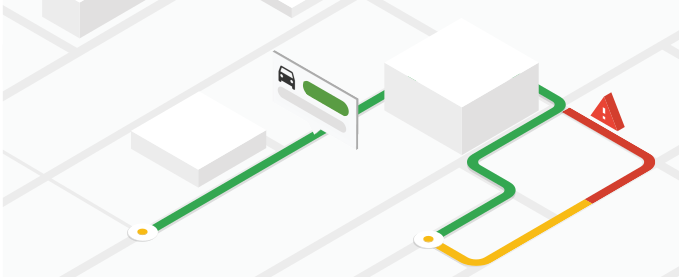
أسباب استخدام Directions API
باستخدام Directions API، يمكنك الحصول على اتجاهات لعدة وسائل نقل، مثل النقل العام أو القيادة أو المشي أو ركوب الدراجات.
ما هي الإجراءات التي يمكنك تنفيذها باستخدام Directions API؟
باستخدام Directions API، يمكنك احتساب الاتجاهات بين المواقع الجغرافية، بما في ذلك التفاصيل التالية:
- اتجاهات لعدة وسائل نقل، بما في ذلك النقل العام أو القيادة أو المشي أو ركوب الدراجات
- الاتجاهات المتعددة الأجزاء باستخدام سلسلة من نقاط الطريق
- يمكنك تحديد نقاط البداية والوجهات ونقاط المرور بعدة طرق، بما في ذلك كسلاسل نصية (مثل "شيكاغو، إلينوي" أو "داروين، الإقليم الشمالي، أستراليا")، أو معرّفات الأماكن، أو إحداثيات خطوط الطول والعرض.
طريقة عمل Directions API
تعرض Directions API المسارات الأكثر كفاءة عند احتساب الاتجاهات. يأخذ المنتج في الاعتبار عناصر السفر التالية عند تحديد المسار الأكثر كفاءة:
- مدة الرحلة (أساسية)
- المسافة
- عدد الدورات
يعرض طلب المثال التالي تعليمات القيادة من تورونتو، أونتاريو إلى مونتريال، كيبيك بتنسيق JSON:
https://maps.googleapis.com/maps/api/directions/json ?destination=Montreal &origin=Toronto &key=YOUR_API_KEY
الموارد
يلخّص الجدول التالي الموارد المتاحة من خلال Directions API بالإضافة إلى البيانات التي يعرضها.
| موارد البيانات | البيانات التي تم عرضها | تنسيق القيمة التي يتم إرجاعها |
|---|---|---|
| الاتجاهات
قدِّم المصادر والوجهات على شكل أرقام تعريف الأماكن أو العناوين أو إحداثيات خطوط الطول والعرض. راجع المعلمات المطلوبة للحصول على التفاصيل. |
اتجاهات مفصلة، مقسمة إلى طرق، وأرجل، وخطوات. راجع استجابات الاتجاهات للحصول على التفاصيل. |
|
كيفية استخدام واجهة برمجة التطبيقات (API) الخاصة بالاتجاهات
| 1 | بدء الإعداد | ابدأ بإعداد مشروعك على Google Cloud واتّبِع تعليمات الإعداد التي تلي ذلك. |
| 2 | جرب النسخة التجريبية | بمجرد حصولك على مفتاح API ومشروع سحابي، يمكنك تجربة العرض التوضيحي للتعليمات دون أي تكلفة. راجع العرض التوضيحي لواجهة برمجة التطبيقات Directions API. |
| 3 | إنشاء طلب | راجع طلبات المثال وتعرف على الخيارات المتاحة التي يمكنك تقديمها، مثل أوضاع السفر ونقاط الطريق وقيود الطريق. أمثلة على الاتجاهات |
| 4 | فهم أساسيات الاستجابة | استكشِف ردود البيانات لتستعد لاستخدام بيانات الاتجاهات في تطبيقك. راجِع ردود الاتجاهات للحصول على التفاصيل. |
| 5 | دمج بيانات الاتجاه في تطبيقك الخاص! | يمكنك استخدام هذه البيانات لحساب مسافة التنقّل ومدته. |
مكتبات العملاء المتاحة
يمكنك طلب بيانات من واجهة برمجة التطبيقات هذه باللغة التي تختارها من خلال إحدى مكتبات البرامج التالية:
- Java Client for Google Maps Services
- برنامج Python العميل لخدمات "خرائط Google"
- Go Client for Google Maps Services
- Node.js Client for Google Maps Services
إنّ Java Client وPython Client وGo Client وNode.js Client لخدمات "خرائط Google" هي مكتبات عملاء متاحة للجميع ومفتوحة المصدر بموجب ترخيص Apache 2.0. يمكنك تنزيلها من GitHub، حيث يمكنك أيضًا العثور على تعليمات التثبيت ونموذج الرمز البرمجي.
الخطوات التالية
- بدء استخدام Directions API: انتقِل إلى البدء.
- بدء تقديم طلبات الاتجاهات: انتقِل إلى الحصول على الاتجاهات.
- اتّباع أفضل الممارسات: انتقِل إلى أفضل الممارسات المتعلّقة بخدمات الويب.

